   |
GO TO PART 1 |    |
   |
GO TO PART 1 |    |
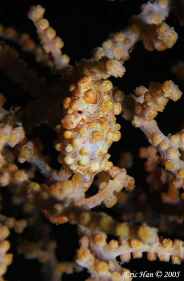 On the Monday morning, itinerary was: Dive 1 at Derawan Lighthouse, dive 2 and dive 3 at Maratua. The first dive was slated to move out at 0820 hrs, 10 minutes earlier than the day before. Mike must have planned to give us an extra 10 minutes in order to move out at 0830 hrs; to no avail. The highlight of the first dive site were yellow pygmy seahorses residing on a yellow gorgonian at 25-metre depth, red pygmy seahorses 10 metres away from the yellow ones, at 20-metre depth, and long-snout hawkfish. We did not see the long-snout hawkfish, but the pygmy seahorses were there waiting for us. The gorgonians were found on a 50° slope, accompanied by plenty of sea whips. On this slope, the corals came to fore only from 15 metres upward, becoming thicker as the depth lessened, accompanied by the usual plethora of rich reef life.
On the Monday morning, itinerary was: Dive 1 at Derawan Lighthouse, dive 2 and dive 3 at Maratua. The first dive was slated to move out at 0820 hrs, 10 minutes earlier than the day before. Mike must have planned to give us an extra 10 minutes in order to move out at 0830 hrs; to no avail. The highlight of the first dive site were yellow pygmy seahorses residing on a yellow gorgonian at 25-metre depth, red pygmy seahorses 10 metres away from the yellow ones, at 20-metre depth, and long-snout hawkfish. We did not see the long-snout hawkfish, but the pygmy seahorses were there waiting for us. The gorgonians were found on a 50° slope, accompanied by plenty of sea whips. On this slope, the corals came to fore only from 15 metres upward, becoming thicker as the depth lessened, accompanied by the usual plethora of rich reef life.
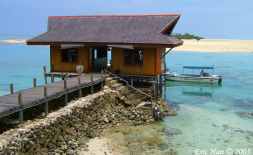 The journey to Maratua lasted slightly more than an hour. 2 other dive resorts are located on this atoll. Maratua Paradise Resort on the western side near a village, operated by a Malaysian concern; and Nabuccio located on a small island near the eastern end of the fishing-hook that describes Maratua, operated by the Germans. Our first dive was at Maratua Lighthouse, along the north-east side of the atoll. The visibility was the clearest for this dive, with no palpable current. The slope was almost a vertical wall, covered with a rich variety of reef life. The place was made for a slow and very soothing underwater swim. Every now and then, I would look out into the blue, hoping nature would spring a pleasant surprise of some big pelagic life, but it was not to be. The only thing interrupting the soothing blueness was the silhouette of Eric, who had finned far away from the wall, his camera ready, carrying the same hope as me in his heart.
The journey to Maratua lasted slightly more than an hour. 2 other dive resorts are located on this atoll. Maratua Paradise Resort on the western side near a village, operated by a Malaysian concern; and Nabuccio located on a small island near the eastern end of the fishing-hook that describes Maratua, operated by the Germans. Our first dive was at Maratua Lighthouse, along the north-east side of the atoll. The visibility was the clearest for this dive, with no palpable current. The slope was almost a vertical wall, covered with a rich variety of reef life. The place was made for a slow and very soothing underwater swim. Every now and then, I would look out into the blue, hoping nature would spring a pleasant surprise of some big pelagic life, but it was not to be. The only thing interrupting the soothing blueness was the silhouette of Eric, who had finned far away from the wall, his camera ready, carrying the same hope as me in his heart.
The dive ended regrettably about an hour later. And the boat headed into the lagoon of the atoll, making its way to Nabuccio island, for us to have lunch on terra firma. Just before the trip, Mike had asked us to bring some money, just in case we would like to buy some Nabuccio souvenir - only USD or Euro was legal tender though, no rupiahs. The resort at Nabuccio was quaint and relatively silent, and therefore calm. There was only our own chatter against the soft whisperings of nature, as we stripped out of our wetsuits and started digging into our lunch at the bar housed on a verandah overlooking the shallow lagoon. With lunch finished and time on our hands, some of us wandered around the resort, using the very clean and beautifully designed outhouse (segregated into male and female rooms), and to the souvenir shop - but didn't spend any money there, as the variety was limited and the prices quite discouraging. I even wandered to the restaurant section, and saw a wine cabinet filled with German wines and champagne! We wanted to order some drinks, but the prices at the bar was as discouraging; a can of coke would set us back by 1.50 €.
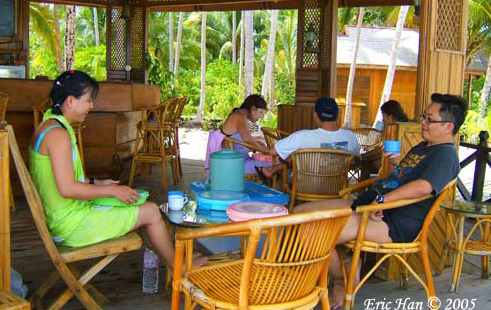 The time for our second dive at Maratua came, and Mike appeared to brief us with the aid of another papier mache 3D-model of the dive site: Big Fish Country. The site is located just outside the mouth of the channel leading into the lagoon, on the eastern end of the Maratua fish-hook. As the name implies, there were big fishes waiting for us there: sharks, bumphead parrotfish, schools of giant trevallies, barracudas and big jacks. We were fortunate to be there at the correct time, high tide, with water rushing into 20-metre wide channel, the big fishes would definitely be there. The boat dropped us on the northern side of the channel, just beyond the 10-metre coral shelf, and we were supposed to avoid the shelf, finning deeper beyond it to the edge of a second coral shelf reaching a depth of 25 metres. We could feel the strong current the moment we hit water, I had to struggle against the current bit to get to the second shelf. Soon all of us were lined up along the dropoff, like we were preparing for an ambush; Mike and Amy were first in the line of ambush, and I was next, a few metres away. The shelf was almost devoid of live corals and strewn with coral rubbles, and we had to carefully make our way towards the channel mouth using whatever handholds we could find, looking over the edge and down the dropoff, as the current swept into our faces. It was like doing horizontal rock climbing, moving sideways (like crabs). Soon, Mike was clanking his steel macro-life pointer against his tank. Mike posed a vertical palm on his forehead, and then pointing ahead into the dropoff - sharks! Silvertips and grey reef sharks, gliding below the dropoff.
The time for our second dive at Maratua came, and Mike appeared to brief us with the aid of another papier mache 3D-model of the dive site: Big Fish Country. The site is located just outside the mouth of the channel leading into the lagoon, on the eastern end of the Maratua fish-hook. As the name implies, there were big fishes waiting for us there: sharks, bumphead parrotfish, schools of giant trevallies, barracudas and big jacks. We were fortunate to be there at the correct time, high tide, with water rushing into 20-metre wide channel, the big fishes would definitely be there. The boat dropped us on the northern side of the channel, just beyond the 10-metre coral shelf, and we were supposed to avoid the shelf, finning deeper beyond it to the edge of a second coral shelf reaching a depth of 25 metres. We could feel the strong current the moment we hit water, I had to struggle against the current bit to get to the second shelf. Soon all of us were lined up along the dropoff, like we were preparing for an ambush; Mike and Amy were first in the line of ambush, and I was next, a few metres away. The shelf was almost devoid of live corals and strewn with coral rubbles, and we had to carefully make our way towards the channel mouth using whatever handholds we could find, looking over the edge and down the dropoff, as the current swept into our faces. It was like doing horizontal rock climbing, moving sideways (like crabs). Soon, Mike was clanking his steel macro-life pointer against his tank. Mike posed a vertical palm on his forehead, and then pointing ahead into the dropoff - sharks! Silvertips and grey reef sharks, gliding below the dropoff.
We continued advancing slowly towards the channel mouth, and then Mike stopped and started waving his wand overhead. I looked up and behold a large school of barracuda! The school was swimming about 5 metres above us into the onrushing current, and it looked like there were several hundreds, if not a thousand. I could see the slight undulation of the barracudas' sleek bodies, but the whole school appeared stationery in the water. The current was strong, and it was the only thing that prevented us from finning up to have a closer look at the school and take a few shots of it. I was sure Eric would have swum into it if he could. Mike and Amy froze momentarily at their positions to appreciate the greatness of nature, and I advanced ahead of them, to make way for the rest behind me. Then I found a large round coral head just at the channel mouth and hung on to it to enjoy the view. We were already 25 minutes into the dive, and the challenging underwater trek had dwindled my air down to 90 bars. A slight turn of the head brought two things into my line of sight: Mike waving his wand continuously at another direction, and Gimmy struggling downward to the shelf-bed to regain her handhold. I was not sure what Mike was waving at, a quick look into the blue revealed nothing to me; then I kept my eyes on Gimmy, to ensure myself that she was alright. She struggled for slightly more than 5 seconds and succeeded to get a handhold, but she stayed in the same position for a few more seconds. 5 seconds sounded short, but on dry land, anybody with 2 legs could comfortably cover 30 metres, and underwater maybe half of that distance. I decided to go to her position to assess her situation more clearly. Halfway to Gimmy's position, I saw Eric, who was nearer, moving towards her, too. I stopped to see how things turned out; then I observed Eric returning with Gimmy's heavy camera and strobes. So I continued my way, to see if I could help her.
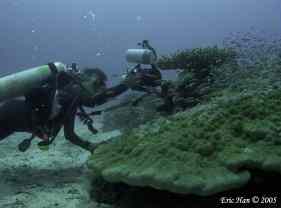 When I reached Gimmy, she was hanging on to a rope tied to her Polynesian reef hook anchored onto a chink in the shelf bed, with the strong current buffeting her around. I questioned her with the OK signal, she just shook her head, but did not indicate what was wrong. I decided to help her out of the situation, maybe to somewhere less extenuating. Holding on to Gimmy's reef hook, I pulled her along with me along the bed towards my first position by the channel mouth. Handholds on the shelf bed were scarce; thankfully, Gimmy's reef hook required only small chinks in the bed, so I needed not expend energy holding on to her constantly. Every now and then I turned to look back at her. She looked okay to me all the while, but she revealed to me later on surface, that she was very tired then and could no longer negotiate her way in the strong current on her own. I was breathing very hard then, and I think Gimmy was, too.
When I reached Gimmy, she was hanging on to a rope tied to her Polynesian reef hook anchored onto a chink in the shelf bed, with the strong current buffeting her around. I questioned her with the OK signal, she just shook her head, but did not indicate what was wrong. I decided to help her out of the situation, maybe to somewhere less extenuating. Holding on to Gimmy's reef hook, I pulled her along with me along the bed towards my first position by the channel mouth. Handholds on the shelf bed were scarce; thankfully, Gimmy's reef hook required only small chinks in the bed, so I needed not expend energy holding on to her constantly. Every now and then I turned to look back at her. She looked okay to me all the while, but she revealed to me later on surface, that she was very tired then and could no longer negotiate her way in the strong current on her own. I was breathing very hard then, and I think Gimmy was, too.
When we reached the channel mouth, I paused. The channel bed, a long indentation on the shelf bed was filled with rubbles, with no apparent handholds in sight. My contents gauged had just dipped into the red segment, catching a glance at Gimmy's gauge, I saw that it was similar, and we were still 25 metres deep and the dive plan had been to terminate the dive further into the channel, where the current would have lessened considerably. In fact, the rest of the group had crossed the 15-metre gap, and moved on as according to the dive plan, thinking that I had everything under control. I then made a quick decision, signaled to Gimmy to move on. I hanged on to Gimmy and let the current swept us up the channel. Mike had earlier warned us that the current in the channel would be unpredictable and it may even suddenly sweep us up to the surface. Thankfully, as the current swept Gimmy and I into the channel, the channel bed was cleared of rubbles. I could every now and then, find a handholds to slow ourselves down, and to keep us close to the bed, which gradually raised up to 10 metres depth.
Very soon, the group came into our sight, about 30 metres away from us. They were doing their 5-metre safety stop! I was sucking hard on my second-stage, as the gauge had gone down to below 10 bars. I think Gimmy's air was running out, too. As the current kept pushing us towards the others, I was executing the out-of-air signal, hoping that they would see. After a few seconds, I saw Mike finning towards us, extending his octopus towards me. I waved at him to give the octopus to Gimmy. But very soon, we found ourselves on the surface, with the rest of the group. I found out later that Gimmy had actually lost her weight belt just before I noticed her struggling to hold on to the shelf bed, and she hadn't realized it then.
Once the surface, I became worried that we might have surfaced too fast. In addition, my Suunto α had beeped to indicate a decompression dive just as we reached the channel mouth at 25 metres depth, but the situation had not allowed us the luxury of a decompression safety stop. Everybody got onto the boat, and Mike gave asked Freddy to immediately return to base. Gimmy and I were laid out flat, too tired to do anything else. As the boat shot off to base, the boat ride became very bumpy; I cushioned my nape with a half-filled bottle, while Gimmy made do with a thigh from Eric. Desmond had Gimmy's legs raised on his thighs. Then Gimmy complained that her left hand had started to get numb. Eric, who had had rescue training, immediately asked Mike if the boat carried oxygen. Mike nodded, and quickly assembled the DAN oxygen kit, and passed it to Eric, who tended to Gimmy. Meanwhile, I only had the comfort of my own water bottle and the gunwale to support my legs. Gimmy recovered and I got a chance at a whiff of the oxygen. After a while the light bantering on the boat restarted, as the oxygen got passed around so that everybody got a taste of what pure oxygen taste like - tasteless lah!
Back at the dive centre, Eric asked for his equipment to be left at the jetty. He need to keep his appointment with his stargazer. I believed he was trying to get his fortune told. We left him to his devices, and went on to get ourselves cleaned up for dinner. But he soon returned from his dive, his strobe batteries had run out! So much for his fortune. Zara, who was left on shore for that day, was at the dive centre, welcoming her parents with a suppressed smile, bravely keeping back the tears.
Tuesday was Kakaban day, both for us and the Brits. Dive 1 and 2 at Barracuda Point, in between which we would be visiting the Kakaban jellyfish lake. Mike produced another 3D model of the dive site, another one with strong current and big fish. In the supposedly camera room at the dive centre (it contained a large variety of plugs for charging batteries, and some simple equipment like the multimeter), hung the photograph of schooling hammerheads, captioned "KAKABAN". Mike toned down our expectation, we might see ONE hammerhead, if we were lucky, but he was sure we would see some big sharks and a barracuda school. Barracuda Point is on the south-west corner of the island, and we would be drifting with the usually strong current in a south-westerly direction on the north side of an underwater promontory until near the end of it. The end was where the barracudas would be, and all of us shall have to hang on to sea whips to stay stationery at the natural grandstand. A long thick rope marked the end of the promontory, and we were supposed not to cross beyond that point, because once the current reached there, it would push down the dropoff into the deep bottom to the sharks' abode. The rope was anchored to a big rock located at depth of 15 metres, and we would have to get there and negotiate over it to the other side of the promontory. The 3D model definitely helped in giving us a good idea of how the situation was going to be.
The boat ride to Kakaban lasted about 45 minutes. We reached the island at about 0915 hrs and put Liana with Zara ashore on a narrow beach on the south side of the island, at the start point of the boarded path to the jellyfish lake. The rest of us then carried on with the first dive of the day. The dive turned out as briefed by Mike. We drifted along the slope of the promontory down to 38 metres, in hope of sighting a hammerhead shark. But fate deemed that we had to be satisfied with a few large grey sharks (Mike said they were pregnant), and the barracuda school, much smaller than that at Big Fish Country. On the other side of the promontory, beyond the big rock, it was a near vertical wall, rich in coral growth, with no current at all. A good relaxing fin after the strong current just before it.
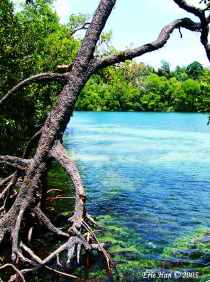
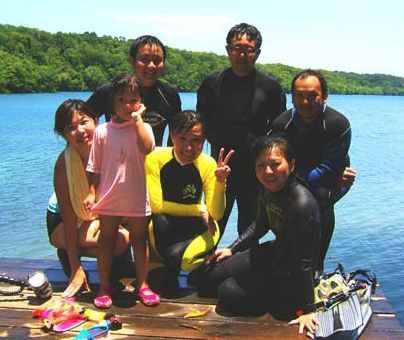 After the dive, all of us went ashore with all our snorkeling gear. Zara welcomed us from a high branch of a tree, and accompanied us on to the lake. The trek lasted only 10 minutes or so, but it was not on flat terrain. It was a hilly trek, across the lip of the coral basin. In addition, the board walk had collapsed at various points, and we had to be very careful of our steps. Scuba diving is not allowed in the jellyfish lake, Mike had explained that expired air bubbles from divers might injure the jellyfish, but I couldn't imagine how. On reaching the lake, we donned our snorkeling gear and frolicked among the stingless jellyfish in the brackish water. As we went further from the edge of the lake, the number of jellyfish increased. There were supposedly 4 different species there, but I could only different 3. The largest one I saw would fit a C-cup. After a while, the Brits arrived and joined the jellyfish party.
After the dive, all of us went ashore with all our snorkeling gear. Zara welcomed us from a high branch of a tree, and accompanied us on to the lake. The trek lasted only 10 minutes or so, but it was not on flat terrain. It was a hilly trek, across the lip of the coral basin. In addition, the board walk had collapsed at various points, and we had to be very careful of our steps. Scuba diving is not allowed in the jellyfish lake, Mike had explained that expired air bubbles from divers might injure the jellyfish, but I couldn't imagine how. On reaching the lake, we donned our snorkeling gear and frolicked among the stingless jellyfish in the brackish water. As we went further from the edge of the lake, the number of jellyfish increased. There were supposedly 4 different species there, but I could only different 3. The largest one I saw would fit a C-cup. After a while, the Brits arrived and joined the jellyfish party.
Half an hour later, we made our way back to the beach for our lunch. And the tide had gone down, leaving the coral beds exposed to the sun. At about 1300 hrs, Mike waved for the boat to approach the shore, but it was too shallow. Leaving behind Desmond with Zara, we had to trudge our way slowly to the edge of the coral shelf. At the coral shelf edge, near to the boat with waters to our knees, the corals were very healthy, and the girls were wont to step on the brittle corals. But the main concerned was to tread as carefully as possible in order not to get ourselves cut by the sharp corals. I felt that my booties soles weren't thick enough then.
The second dive at Barracuda Point was about the same, except that the barracuda school had disappeared, leaving behind a few stragglers. And no hammerhead. But after the dive, the Brits who had gone down just after us, told us that they sighted one, quite deep down the dropoff, just as they started their ascent from 30 metres. I was quite doubtful, I thoughtful they were just seeing things. Sour grapes? Maybe.
We passed a good 20 minutes on the calm lee side of the promontory. We finished the dive and the boat made its way back to the beach to retrieve Desmond and Zara. Apparently, at the sight of our boat, Desmond had carried Zara and trudged out to the coral shelf. It definitely was tough to negotiate the way among the uneven sharp corals carrying a child; in fact, Desmond slipped and got a small cut on his left thigh. The Brits were nearer to them, and Graham, the tallest one, jumped off the boat to help bring Zara to their boat. We cheered as Zara and Desmond transferred to our own boat.
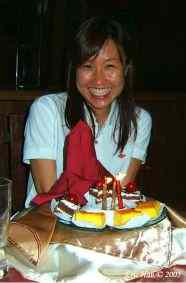 The third dive of the day was at Snapper Point at Derawan. After the strong current at Barracuda Point, Snapper Point was rather staid. The dive started at 1610 hrs and ended an hour later. I was feeling good, and decided to join Gimmy and Eric for the night dive. Mike was hoping to show them the boxer crab residing below the jetty. The dive lasted 100 minutes but it was not fight night, so the boxer crab did not turn up.
The third dive of the day was at Snapper Point at Derawan. After the strong current at Barracuda Point, Snapper Point was rather staid. The dive started at 1610 hrs and ended an hour later. I was feeling good, and decided to join Gimmy and Eric for the night dive. Mike was hoping to show them the boxer crab residing below the jetty. The dive lasted 100 minutes but it was not fight night, so the boxer crab did not turn up.
I was feeling tired but rather hungry when we turned up late for dinner. The day's excitement continued when the chef turned up at our table with a combo of little cakes topped by candles. It was Amy's birthday! He was apologetic about not being able to produce a proper cake since he was informed only just a while before. We sang a birthday song, and the candle was blown, and everybody in the dining hall clapped. I was still not eating well, but the little chocolate cakes were good. I went to bed immediately after dinner. But the night did not end for the rest. Near midnight, a beaching turtle was spotted, and some of the group went off for a spot of turtle peeping.
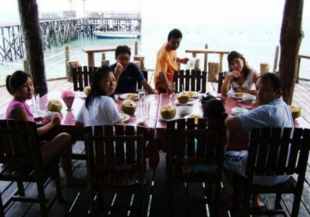 For the next two days, we returned to Sangalaki, hoping to see the mantas. The Brits had claimed to have sighted about 10 of them at Manta Parade, the day before our arrival! But we were thoroughly disappointed, and Mike was crestfallen about being let down by the mantas going on holiday. On the first no-manta day, we had lunched on the Sangalaki southern beach, at the Sangalaki Dive Resort. When we beached, the tide was just starting to go down, and there was enough depth for the boat to approach the beach. Two hours later, the tide was totally out, and once again we had to trudge in shallow water out to the boat. This time it was better, the bottom was sandy until near the dropoff, where we had to cross a 5-metre stretch of healthy and sharp corals. And Desmond had to gingerly negotiate the coral stretch with Zara in his arms again! The second no-manta day, we stuck to the boat for our lunch.
For the next two days, we returned to Sangalaki, hoping to see the mantas. The Brits had claimed to have sighted about 10 of them at Manta Parade, the day before our arrival! But we were thoroughly disappointed, and Mike was crestfallen about being let down by the mantas going on holiday. On the first no-manta day, we had lunched on the Sangalaki southern beach, at the Sangalaki Dive Resort. When we beached, the tide was just starting to go down, and there was enough depth for the boat to approach the beach. Two hours later, the tide was totally out, and once again we had to trudge in shallow water out to the boat. This time it was better, the bottom was sandy until near the dropoff, where we had to cross a 5-metre stretch of healthy and sharp corals. And Desmond had to gingerly negotiate the coral stretch with Zara in his arms again! The second no-manta day, we stuck to the boat for our lunch.
The Sangalaki dives were however highlighted by a large leopard shark sweeping about, and a large cuttlefish smirking at our impatience over the absence of the mantas. The grass eels were forever trying to entertain us with their boring up and down bopping line dancing. I even had time to dig out some olive shells and baby marlin spikes from the sandy bed and uncovered a few large tiger cowries among the coral outcrops lining the sandy boulevard of Manta Parade.

 On the last morning at Derawan, Gimmy and Eric rounded off the trip with a morning jetty dive. Amy and I decided to venture beyond the resort grounds. After 20 minutes of leisurely walk to the east along the beach, we came across a kampong, and then the kampong school. It must have been between sessions for some classes because many children were in the playground. After a sweaty and thirsty one-hour walk, we returned to the resort, wondering what would be served for lunch. Soon all of us were packed up, and Eric settled the bill. The last Sangalaki was not covered in our dive package and we had to shell out US$180.00 for the extra trip to Sangalaki. The lunch turned out to be very good, and I had recovered my appetite the day before, blessed me! I wolfed down several helpings of chicken kebabs, home-made potato chips, fish fingers and fried mee, all of it washed down with a fresh green coconut!
On the last morning at Derawan, Gimmy and Eric rounded off the trip with a morning jetty dive. Amy and I decided to venture beyond the resort grounds. After 20 minutes of leisurely walk to the east along the beach, we came across a kampong, and then the kampong school. It must have been between sessions for some classes because many children were in the playground. After a sweaty and thirsty one-hour walk, we returned to the resort, wondering what would be served for lunch. Soon all of us were packed up, and Eric settled the bill. The last Sangalaki was not covered in our dive package and we had to shell out US$180.00 for the extra trip to Sangalaki. The lunch turned out to be very good, and I had recovered my appetite the day before, blessed me! I wolfed down several helpings of chicken kebabs, home-made potato chips, fish fingers and fried mee, all of it washed down with a fresh green coconut!
After lunch, our luggage was loaded onto the boat that would bring us back to Berau. We would pass one night there, before flying back to Singapore at 0800 hrs the next morning. The Brits and the Japs were booked on the same flights as ours, but they have opted to stay at the resort. They would have to start their journey at 0500 hrs the next morning!
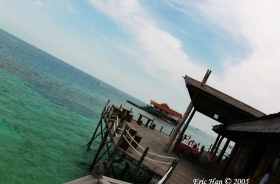
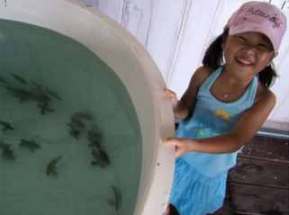 To top off the exciting holiday, just before the boat pushed off for Berau, we visited the barramundi cod fry farm located 30 metres from the jetty end platform, a new project by the resort owner. The consultant, invited to oversee the operations, had introduced himself to us 2 nights before, and had invited us to tour the facilities. The tour was really interesting, there was a tank containing two big barramundi cods recently caught in the Derawan seas, each about 7 to 9 kilograms. They were ready to spawn the eggs which would be gathered and hatched on the farm. The hatching would take only a day. There were also 4 other tanks containing the barramundi cod fries - at various stage of growth, all more than 4 centimetres in length. We were told these could be sold to barramundi cod farms for US$2.00 each, while they cost only US$0.20 to raise - a tenfold capital increment.
To top off the exciting holiday, just before the boat pushed off for Berau, we visited the barramundi cod fry farm located 30 metres from the jetty end platform, a new project by the resort owner. The consultant, invited to oversee the operations, had introduced himself to us 2 nights before, and had invited us to tour the facilities. The tour was really interesting, there was a tank containing two big barramundi cods recently caught in the Derawan seas, each about 7 to 9 kilograms. They were ready to spawn the eggs which would be gathered and hatched on the farm. The hatching would take only a day. There were also 4 other tanks containing the barramundi cod fries - at various stage of growth, all more than 4 centimetres in length. We were told these could be sold to barramundi cod farms for US$2.00 each, while they cost only US$0.20 to raise - a tenfold capital increment.
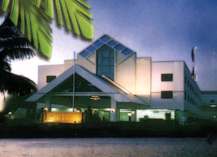 At 1415 hrs, we finally made our way to Berau. Along the Berau river, near to the town, it rained lightly for a while. At Berau, we put up at the best hotel of the town: Hotel Bumi Segah. The room was priced at US$30.00 a night, with breakfast. There was no lift in the hotel, so we had to leave all our heavy luggage in a baggage room and lugged our own personal effects up 3 floors to our rooms. (The winsome lone bellboy went pale when we had wanted him to bring all our luggage up to our rooms.) We refreshed ourselves, and took a short walk outside the hotel. The hotel faces the river, Sungai Segah, along which are lined up several stalls swatched with canvas advertising all sorts of barbecued seafood. All along the straight narrow road by the river were little shops and small stalls selling sundry provision and local confectionery. There were also a few stalls selling bottled petrol and diesel. After passing a few of the stalls, I then spotted one with a refrigerator, and I immediately felt my throat crying out for a can of chilled coke. We bought several cans of chilled drinks (5000 R a can), a packet of milk (for Zara), and a pack of cards to while the evening away.
At 1415 hrs, we finally made our way to Berau. Along the Berau river, near to the town, it rained lightly for a while. At Berau, we put up at the best hotel of the town: Hotel Bumi Segah. The room was priced at US$30.00 a night, with breakfast. There was no lift in the hotel, so we had to leave all our heavy luggage in a baggage room and lugged our own personal effects up 3 floors to our rooms. (The winsome lone bellboy went pale when we had wanted him to bring all our luggage up to our rooms.) We refreshed ourselves, and took a short walk outside the hotel. The hotel faces the river, Sungai Segah, along which are lined up several stalls swatched with canvas advertising all sorts of barbecued seafood. All along the straight narrow road by the river were little shops and small stalls selling sundry provision and local confectionery. There were also a few stalls selling bottled petrol and diesel. After passing a few of the stalls, I then spotted one with a refrigerator, and I immediately felt my throat crying out for a can of chilled coke. We bought several cans of chilled drinks (5000 R a can), a packet of milk (for Zara), and a pack of cards to while the evening away.
We had our dinner of local fare at the hotel, western cuisine was much dearer. A small group of Japanese from the Maratua Paradise Resort had arrived at the hotel a few minutes after us. Two of them made their way to the make-shift stalls outside the hotel to savour the advertised barbecued fish and various seafood. But they returned disappointed, the stalls had no fish!
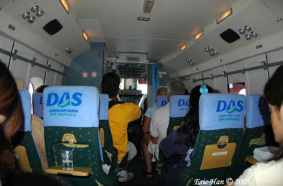 The next morning the Derawan Dive Resort staff stationed in Berau came at 0645 hrs to fetch us to the Berau airport. It was just a 15-minute ride. We were the first people there, and in no time, the British and Japanese groups appeared. We would not be taking the Trigana (Kalstar) airplane back to Balikpapan. A smaller plane had been chartered from the Dirgantara Air Service by the Derawan Dive Resort to ferry all their guests to Balikpapan. The small propeller driven plane was much more comfortable than the KalStar/Trigana flight we took previously, and there wasn't any air hostesses, but who needed one on an 1-hour flight?
The next morning the Derawan Dive Resort staff stationed in Berau came at 0645 hrs to fetch us to the Berau airport. It was just a 15-minute ride. We were the first people there, and in no time, the British and Japanese groups appeared. We would not be taking the Trigana (Kalstar) airplane back to Balikpapan. A smaller plane had been chartered from the Dirgantara Air Service by the Derawan Dive Resort to ferry all their guests to Balikpapan. The small propeller driven plane was much more comfortable than the KalStar/Trigana flight we took previously, and there wasn't any air hostesses, but who needed one on an 1-hour flight?
We rediscovered creature comforts we were used to, the moment we climbed into the SilkAir plane at Balikpapan - newspapers from Singapore. The return trip was uneventful. Only one question remained: Would any of us return back to Derawan to try for the mantas again? I don't know about the others, but I thought I might. The Derawan staff had informed us that high season for mantas is from April to June.
   |
END |    |